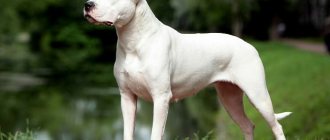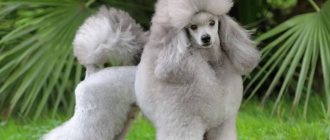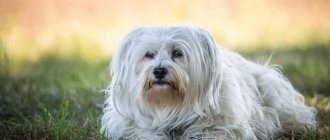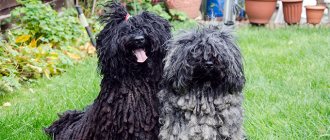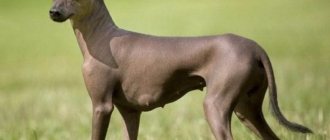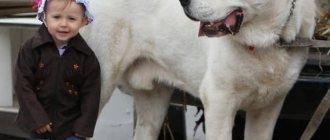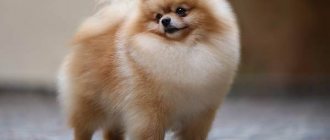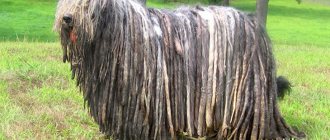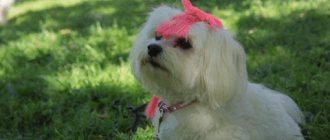One of the attractive traits of dogs that most breeds have is floppy ears. They look funny and give the dog a playful look. Long ears are more typical for “hunters”, but the list includes both guard and decorative dogs.
Why do most dogs have long floppy ears? Geneticists associate this fact with the role of domestication of the Wolf family. In the process of evolution and selection, the embryonic development of the ear crest associated with the nervous system is disrupted. Dogs with floppy ears are softer, more flexible, and easier to train. They produce less adrenaline and are less aggressive. This directly depends on the functioning of the endocrine system.
Domestication led to the emergence of breeds characterized by low auricles and weak cartilage. The same factor affects color, cartilage stiffness, and pigmentation due to selection work.
In some cases, intrauterine disruption of the development of the ear ridge leads to underdeveloped cartilage tissue. Owners have to resort to various methods, including surgery, to restore the rigidity of the auricle. This is especially true for those breeds whose standard specifies requirements for ear position. Much easier for those who choose dogs with floppy ears.
English Setter
This is a large pointing dog originally from England. Bred for hunting waterfowl . Height at withers is 61-68 cm , weight is not regulated by FCI rules. It has an oval skull and a rectangular deep muzzle, an elegant muscular body, long legs, a tail in the form of a Turkish saber, which is an extension of the back.
The ears are low set, quite long, hang down, forming folds, the top is covered with wool, the tips are velvety . The coat is slightly wavy, long on the chest, belly and tail, the front legs and thighs are decorated with feathering. The color is speckled on a black, orange, yellow or brown background, sometimes with tan. The character is very friendly, lively and energetic.
Bloodhound
These melancholic at first glance, but very active dogs, have a strong, colorful body. The chest is voluminous with a prominent keel. The paws are massive and set straight. The tail is thick, shaped like a saber. Height - 58-68 cm.
The head is specific: large, rectangular in profile. The stop is moderate, transitioning quite smoothly into the nose with a hump. The lips are dense, but soft. In this case, the upper one completely covers the lower one and hangs down a little. The jaws are massive. The eyes are positioned normally, but the lower eyelid may droop. The bite is predominantly scissor, but a straight bite is allowed. The ears are set on soft cartilage, thin and velvety to the touch, hanging down to the base of the neck.
The soft skin, forming many folds, is covered with coarse wool, colored black-red or completely red.
Basset Hound
This is an old English breed, bred for hunting on foot in flat terrain for badgers, hares, and foxes . Thanks to their data, they were able to follow the trail for several hours. One of the characteristics of the breed is a sharp loud bark, similar to a roar.
Dogs are 33-38 cm high at the withers, with a body weight of 18-29 kg . They have a massive elongated body, short limbs, sad folds on the muzzle and a tired look. A characteristic feature is the long narrow ears, curled inward, slightly extending beyond the tip of the nose when extended. The color usually consists of 3 colors (black, white, brown), sometimes red and white, rarely pure red, the tip of the tail is light.
These are friendly dogs, smart, with an excellent sense of smell, and are easy to train. Often used in the role of rescuers, as well as to search for prohibited substances. Basset Hounds are excellent companions and love children and animals.
Ariegeois
Externally, the dog is dry and bony. The body itself is rather narrow, elongated and squat, but the overall appearance is harmonious. The neck is oblong, convex and extends into a shallow chest. Paws with strong bones, hare-shaped, due to which Ariegeois can quickly develop speed. The saber tail starts high. Height 55-58 cm, without clear sexual differentiation.
Head with a convex cranial vault. The bridge of the nose is straight, but a slight hump is acceptable. The lips fit tightly and do not form pronounced jowls. The ears are hanging type with an oval end, elongated to the base of the neck. Located on soft cartilage, set low.
The hairline is soft and short, close-fitting. The color is white with black speckles, there is a symmetrical mask on the muzzle, affecting the eyes and ears.
Beagle
The modern type of dog was bred in the 19th century in Britain to chase hares and foxes, including in horse hunting. Usually used in a pack of 25-30 individuals. Nowadays they are rarely used in hunting; they usually act as a pet, for an exhibition career or as a search animal.
The dog is 33-40 cm tall at the withers, weighing 9-14 kg . It has a muscular body, a large head, and slightly shortened limbs. The coat is short in length, with any hound color except liver, the tip of the tail is always white, raised up. They are distinguished by rounded ears, tightly fitting to the cheekbones, and length almost to the tip of the nose.
Dogs are extremely energetic, inquisitive and stubborn. Another feature of beagles is their deep voice, the strength of which is disproportionate to their height. They are friendly, love children, and get along well with other animals.
Poodle
Intelligent, graceful, and amazingly athletic, poodles were originally bred as hunting dogs. Their bouncy, curly fur does not shed much and serves as an excellent insulating layer in cold or humid climates. Of course, poodles require quite a bit of grooming, whether they have the typical lion cut or you prefer to comb their locks.
Poodles are easy to train due to their intelligence and eagerness to please, and they also excel in sports such as tracking and agility. It is also worth noting that poodles are excellent swimmers, competing with Labradors and golden retrievers.
Great Dane
One of the largest and most ancient dogs, Germany is considered the birthplace of modern representatives of the breed. Great Danes, according to the standard, should reach 72-90 cm at the withers. They have a square body, elegant legs, a large long head with a rectangular muzzle. The ears are hanging, of pronounced length, adjacent to the cheeks only with the leading edge.
The coat is very short, shiny, and comes in a variety of colors, including brindle and harlequin. The character is self-confident, fearless, but without aggression, friendly, especially towards children, reserved with strangers.
Afghan Hound
Despite all its elegance and grace, the Afghan Hound is distinguished by its endurance and strong physique. The height of an adult female varies from 60 to 68 cm, and males grow up to 72 cm. The main “tools for running are: straight legs and a capacious chest, which ensures the smooth functioning of the heart and voluminous lungs. The straight tail is located quite low. The elongated muzzle and wide-set eyes provide maximum visibility of the terrain when running. The ears are drooping and elongated.
The pride of the breed is the silky straight hair that covers the entire body except the head - here it is short. Any color is allowed, but white spots are unacceptable.
Read Top 20 best guard dogs for protecting a private home
Drathaar
A German pointer bred to track game, alert the owner, carry carcasses, and also hunt wild boar. Height – 57-68 cm, weight is not regulated. The body of the animal is almost square, the chest is deep, the stomach is tucked, the tail is of moderate width and can be docked. The ears are set high, set wide apart, fairly long, not pointed or curled.
The coat is hard and short, with pronounced eyebrows and a beard. Colors:
- brown or black with gray hair (with or without spots);
- gray;
- pure brown with or without light chest markings.
The dog's character is balanced, not timid, firm, there is no aggression towards people.
Black and tan coonhound
The body has a square shape with well-developed muscles. The chest is voluminous, the legs are elongated, with strong bones. The front ones are straight, and the rear ones are slightly set back. The tail is moderately thick, but set rather low. Height - 63-70 cm.
The head and muzzle look very noble: dry, with a regular rounded forehead and prominent eyebrows. The stop is noticeable, but not clearly defined. On the rectangular muzzle there are drooping lips that form small folds at the corners of the mouth. The jaws are massive and have a scissor bite. The ears are located quite low and closer to the back of the head. The soft cartilage creates beautiful folds.
The coat is shiny, moderately soft and short. But special attention is paid to the noble color: pure black with barely noticeable red tan markings in the eye area, on the sides of the muzzle, on the chest and limbs.
Chinese Crested
This is an elegant companion dog, the origins of which are not fully understood. The height at the withers is 23-33 cm , the weight is not established by the rules, usually no more than 6 kg. The breed is presented in 2 types:
- downy (the entire body and limbs are covered with long, light hair);
- naked (hair only on the tail, muzzle, tips of the paws).
It has a graceful head, large erect ears with a low set, which may be covered with a fringe of long hair . For the down variety, drooping ears are acceptable. These dogs are very vulnerable, obedient, and do not like strangers.
Ear care tips
A dog's hearing organs are vital. The natural mechanism provides for self-cleaning. Those with floppy ears require special treatment. This may include:
- dirt, dust (especially in urban environments);
- water while swimming or in bad weather.
Often the organ is “attacked” by exoparasites, which are difficult to get rid of. In addition, hearing is connected with the organs of smell and touch. Any cold or infection can lead to a complete loss of the ability to hear.
There are two types:
- Daily. After a walk, you need to examine not only the body, paws, but also the ears. If necessary, wipe the ear curls and ears from accumulated wax.
- Prophylactic. This procedure is performed by a veterinarian during a general examination of the dog.
Once every two weeks, the ears are treated with a special lotion using napkins and sticks, then wiped clean.
A similar procedure should be done more often for dogs in the autumn-spring period, if the ears are too long and touch the floor or ground.
They start wiping from the inner surface, then move to the outer side. It is strictly forbidden to use alcohol tinctures or boric acid.
After bathing, the animal shakes out the water itself. This happens on an instinctive level. It would be good if you could help wipe it clean with a napkin.
Warning signs that the dog’s health is not in order are:
- frequent shaking of the head;
- scratching with hind paws;
- rash on the inner surface, at the base of the ears;
- leaning to any side when walking or sitting.
The most dangerous sign of the disease is an unpleasant odor from the ear. You cannot fix the problem on your own or use medications for humans. Only a veterinary otolaryngologist can make a diagnosis and prescribe treatment.
It is necessary to teach hygiene procedures from puppyhood. Do this calmly, measuredly, without shouting or irritation. The dog will gladly turn his ears up if you teach her this with the help of treats and boasting.
Cocker Spaniel
This is a hunting dog, which has recently become more common as a companion and show dog. The height of the American cocker is 35.5-38 cm , minor deviations are acceptable. Weight is not regulated. The body is slightly elongated, sloping towards the docked tail, the skull is rounded, the muzzle is wide, rather short, the eyes are round, with a touching expression.
The ears are very long, thin, the base is not lower than the upper line of the eyes, and resemble blades in shape. The coat is silky, straight, a slight wave is acceptable. Length from short on the muzzle to very pronounced on the ears, head, belly and paws. Colors :
- any plain color;
- tan;
- mixed (any tone in combination with white).
The character is balanced, friendly, active behavior. Good with children and other animals.
Pointer
The pointer is a cop, and hunting assistants are still mandatory participants in the hunt. Easy to train, incredibly beautiful working dogs that are a pleasure to watch while in the field. A distinctive feature of the Pointer's work is its stance, when, sensing game, the dog freezes, pointing its body in the direction of the prey. This is a smart, strong dog, with a gentle character, friendly, cheerful. The Pointer requires a high level of physical activity, ideal for active people or professional hunters.
Papillon
This companion dog is a variety of the Continental Toy Spaniel, the country of origin is disputed by several states. An elegant and light creature, height at the withers – 28 cm , weight – from 1.5 to 5 kg .
It has large, erect, high-set ears, and the shells are well open. The hearing organs are strong, shifted back, distant from each other, the inner edge is located at an angle of 45°. The ears are covered with long hair and resemble butterfly wings, which gives the breed its name.
The body is covered with slightly wavy, soft hair of pronounced length, there is no undercoat, there are “frills” and “pants” on the paws. The dog is friendly, devoted to its owner, with a stable psyche.
What to look for when choosing a puppy
Heredity is a heavy burden that any owner can face. There are no absolutely healthy purebred dogs. Even if a dog is not sick with anything in its youth, it has a tendency to certain diseases.
To minimize the risks of hereditary diseases, you need to check the following points:
- “Meet” both of the puppy’s parents. The exception is mating with a male from another city/country or artificial insemination. In this case, the breeder must have a complete package of copies of the dog’s documents in his hands.
- If the breed is prone to serious diseases (dysplasia, heart disease, brain defects), all puppies should be examined before sale.
Porselen
Also called porcelain hound or royal hound . A rare breed, bred several centuries ago in France. This is a hunting dog, originally intended to herd hare, roe deer, wild boar, could follow the scent of a wounded animal, and was used in a pack. The name of the breed comes from its color and graceful exterior.
This is a large dog, 53-58 cm , weighing 26-30 kg . Porselen is an elegant dog with long legs. The coat color is white with orange spots. It has an elongated, extensive skull and a whip-like tail. The ears are thin, pointed, curled inward, reaching the nose when pulled out.
This is a balanced, kind, but active dog at home; during the hunt, it embodies excitement and impulsiveness.
Italian spinone
The Spinone is a rare breed of dog, it is a versatile hunter, used as a gun dog, but stands like a pointer. The Spinone Italiano can hunt both on land and in water, even cold water. A special feature of this breed is its wool, which does not get thorns. In the 20th century, the subspecies almost disappeared, because They were replaced by fast spaniels and setters, but thanks to amateur breeders, the breed was revived. Spinone dogs are easy and happy to train, have a gentle, good-natured character, and get along easily with other pets. But small animals will be hunted down as prey. The pet has no aggression towards humans, it is a dog that is patient with children's pranks, and can live in a family even with small children. With all its advantages, the spinone requires a long walk - although it is the slowest hunting dog, it is hardy - it can trot for days without a break.
Shih Tzu dog
One of the oldest breeds, originally from China, for a long time lived only at the imperial court . The name of the breed translates as “lion cub”. This is a short animal (no more than 27 cm at the withers), body weight - 4.5-8.1 kg . The dog has a slightly elongated body, a large wide head, short limbs and a long tail thrown over its back.
The ears are very long, thick, hanging, profusely pubescent, merging with the neck hair . The coat is abundant throughout the body, dense, not curly, of any shade. On the back of the nose, the hairs grow upward, creating the appearance of a chrysanthemum. The character is calm, not aggressive, independent, arrogant to strangers. Shih Tzus are moderately active, intelligent and alert.
Hugenhund
Beautiful Norwegian hounds are distinguished by their strength and strong bones. The body is rectangular, moderately wide, muscular. The chest is deep, flowing smoothly into a taut stomach and groin. The tail is of medium thickness. Height - 50-60 cm.
The head of the breed is of medium size, proportional to the body. The stop is strongly pronounced and extends onto the straight bridge of the nose. The ears are medium in size; when working, the cartilage turns them slightly forward. The tips are soft triangular in shape.
Read Top 20 most beautiful dogs in the world (+photos)
The coat is thick, slightly rough to the touch, and of medium length. Standard colors:
- ginger;
- yellow-red;
- black and tan;
- black and tan with white;
- white with fawn or yellow spots.
Dachshund
A dog with a low body, short limbs and an elongated muzzle. Bred in Germany for burrow hunting. Height at the withers and weight are not described by the standard, but several categories are distinguished depending on the dimensions (chest circumference). The ears are long, round, high-set, without folds, and characterized by mobility.
The color and length of the coat depends on the type of the breed (wire-haired, long-haired, smooth-haired). This is an active, energetic, but balanced dog that loves to play and eat, and is prone to running away and digging.
Weimaraner
These are luxurious, beautiful and very intelligent dogs with excellent hunting skills. A strong, dry body helps them achieve success in business. The back is straight, slightly wider than most pointers. The chest is not wide and makes it possible to make sudden sweeping movements. The limbs are straight and parallel to each other. It reaches a height of 65-70 cm. The neck is rounded and smoothly flows into the head. The occipital part is rounded with a small tubercle. The forehead is large, and when working, folds of skin appear on it. The transition line of the forehead to the nose is moderate, there is a small hump on the lobe. The jaws are well developed, with a strong grip, lips are taut.
The eyes are round and medium in size. In puppies, the iris is blue, but as they grow older it changes to amber. The ears are large, high and close to each other. They have a clear triangular shape, but are rounded at the ends.
Several types of coat are allowed for this breed:
- short;
- long;
- tough.
Color - from silver-copper to gray-blue.
Toy Terrier
The Russian Toy was bred in the 50s in Russia as a companion dog. The animal is small in stature ( 20-28 cm ), with a body weight of up to 3 kg , has an elegant body with a square body and small eyes. The ears are very large, erect, thin, set high . The main qualities and exterior correspond to the English Toy Terrier, from which the breed developed.
Color black, red, blue or brown and tan . The pet can be smooth-haired or long-haired. The latter also have fringe on the ears and feathering on the limbs. The character of dogs is very restless and cheerful; the animal can become cowardly or angry.
Breton epañol
This is an excellent hunting dog, able to point at game and retrieve it from cover. Strong, fast, agile and alert, the Breton Spaniard is good-natured and friendly, making him a good companion for families. The breed has thick fur, which protects the pet in field conditions and requires regular grooming. This energetic breed needs daily exercise and does well in a family that enjoys outdoor activities .
Did you know that the Breton Spaniole originated in the French province of Brittany, where the breed was first shown in 1896? But back in the early 1700s, paintings by Jean-Baptiste Oudry showed this white and brown dog stalking partridges.
Falen
It is a type of continental toy spaniel. Bred as a companion . Country of origin: France, Belgium or Spain (disputed). This is an elegant dog of small height and weight, all exterior parameters are similar to the Papillon.
The animal's ears are large, hanging, strong, but mobile, rounded at the end, set above eye level. The hearing organs are decorated with long hair tassels. The dog is balanced, obedient, loves its owner and his family, is easy to train, but does not accept cruelty.
Long ears give dogs charm and a unique appearance. They can be erect or hanging along the head, covered with hair or bare, rounded and pointed, but, in any case, they emphasize the individuality of the breed’s exterior.
4.2 / 5 ( 5 votes)
Saint Bernard
A massive and powerful dog, the Saint Bernard was originally bred in Switzerland to rescue travelers stranded during a snowstorm. The breed has two varieties: short-haired and long-haired. Both species have a gentle temperament , making the noble and intelligent Saint Bernard an excellent companion and devoted family dog. But be aware that this breed drools a lot and its coat sheds frequently, requiring regular grooming.
Did you know that the breed was named after Saint Bernard de Menton, the patron saint of climbers and skiers.
Short-legged fold breeds
Short-legged, fold-eared breeds are especially popular because they have an extraordinary appearance. If you are looking for a small dog, the following breeds are worth considering:
- English bulldog.
- Basset Hound.
- Pug.
- Pekingese.
- Norfolk Terrier.
- Jack Russell Terrier.
- Dachshund (mini, rabbit, standard).
- Shih Tzu.
- Japanese Chin.
Most breeds are companions. All dogs, except burrow hunters, need special care and a proper rhythm of life.
How and what to feed your pet
Remember that an illiterate approach to feeding will lead to improper development of puppies. Babies are fed about 6 times a day, adults - 3 times. Keep in mind that your dog almost always wants to eat, so it is important to regulate the frequency of food intake. Find a place to feed your pet. Position the bowl so that your pet's head does not hang down while eating. If you neglect this recommendation, the dog’s cervical vertebrae will become deformed. In addition, improper food intake can lead to twisting of the small intestine.
Include raw or boiled meat in your menu. Feed your pet different vegetables: cabbage, zucchini, eggplant, tomatoes, peppers, carrots. Feel free to give greens, buckwheat and rice porridge. Feed your dog a chicken egg about 2 times a week. Dairy products (kefir, cottage cheese, fermented baked milk, yogurt) are given about 1-2 times every 7 days. It is not recommended to include potatoes, radishes, bones, peas, pearl barley, barley, wheat porridge, fried, flour, spicy and smoked in the menu.
Premium ready-made dry food will help you organize proper nutrition: Acana, Go, Grandorf, Happy Dog, Royal Canin and others. On the packaging, manufacturers indicate recommendations for the use of mixtures: the serving size is written taking into account the weight and age of the dog. Please take these into account before using the feed. As a rule, manufacturers advise giving 2-4 glasses of the mixture per day.
Features of feeding basset hound puppies
Newborns eat every 2 hours. The baby's first dish is mother's milk. When the puppy grows up, ready-made milk formulas are included in his menu. From about one month of age, the frequency of meals decreases to 6 times a day. After a year, the baby is fed 3 times a day. To prevent your dog from suffering from obesity later, remove the food bowl after eating. Do not feed your pet until the next meal.
Diet
The total amount of food is calculated as follows: up to 6 months, 6-7% of food from the dog’s body weight is given; from six months, 3-3.5% of food from the dog’s body weight should be given. The diet should contain high-quality meat: beef, chicken, turkey, lamb, rabbit. Try to give the product in pieces; do not grind it into mince. About 2-3 times a week, meat can be replaced with fish.
If you give cottage cheese, make sure that it is not too fatty. Kefir with a fat content of 3.5% is suitable for feeding. It is useful to give your pet beets, zucchini, white cabbage, bell peppers, pumpkin, cucumbers, greens in the form of parsley, lettuce, and dill. Once a week, include 2-3 cloves of garlic in the menu, 2 times a week - a few tablespoons of sauerkraut. Bran can be mixed with small amounts of food (it is recommended to replace vegetables with it). Additional foods include fruits, but make sure they are not too sweet.


